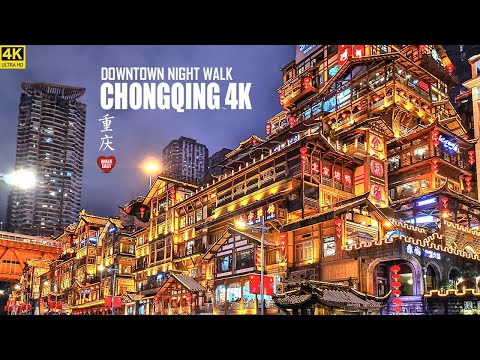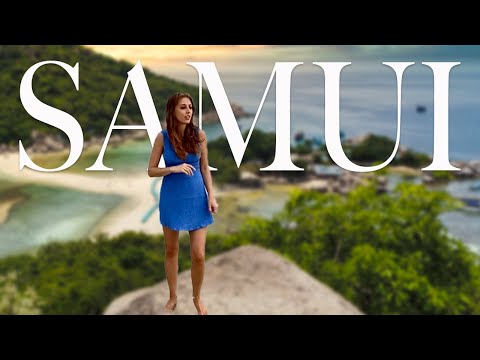Chongqing Night Walk | The Disney-esque Hongya Cave Shopping Area | China Megacity | 4K HDR | 重庆洪崖洞

Hongya Cave is located in the riverside area of the Yangtze River and Jialing River two rivers converge and core business circle of Chongqing Jiefangbei Cangbai Road. It has city tourism landscape, and urban cultural landscape. Ba-yu traditional architectural features of “stilted building” are the main body of Hongya Cave, and it was built according to the mountain, and built along the river.
Hongya Cave has a history of more than 2300 years. "Hongya Cave Folk-Custom Scene Area" project is one of the “eight popular support projects” conducted by the Chongqing municipal government in 2005, a total area of 46000 square meters, is the "key landscape engineering in Chongqing" and "AAA key travel project". It is the best place to visit group of stilted buildings, appreciate Hongya Dicui, stroll mountain city old street, watch ba-yu culture, and taste delicious food, and it is also the Jiangbei lounge. Hongya Cave has a history of over 2,300 years.
It was a military fortress from the ancient Ba State (1046 B.C. - 256 B.C) to the Ming and Qing Dynasties (1368 - 1911), and was also the site of the earliest and most developed pier of ancient China. The site now houses a large-scale stilt house complex built alongside a steep cliff on the bank of Jialing River. It has become a popular destination for visitors to experience Bayu culture - a Chinese ethnic culture, gaze over the river, and taste delicious food. The stunning night view is a highlight and should not be missed. Hongya Cave is an 11-storey, 75 meters (245 feet) stilt house abutting a steep cliff.
It is popular with tourists because it has a similar appearance to a building in Spirited Away - a masterpiece of a famous Japanese cartoonist, Hayao Miyazaki. It is incredible that the 1st floor and the 11th floor are accessible by two different roads. Visitors can take an elevator to each level where various bars, café and restaurants are arranged. Visitors can also see the symbolic Hongya Dripping on the 2nd floor, which is a small waterfall cascading down the cliff-face.
It is regarded as one of the 12 Bayu Sites. Nightscape from 18:00 to 22:00 The nightscape of Hongya Cave is a highlight and is a unique feature of Chongqing. When dusk falls, warm-toned lamps and lanterns brightly light up the stilt house.
Together with its reflection on the water, this shining complex is like a dreamlike pavilion floating among the surrounding towering skyscrapers. Visitors can view the stunning nightscape from different angles. Hongya Cave is located in Chongqing‘s core commercial district of Jiefangbei on Cangbai Road and at the intersection of the Yangtze and Jialing rivers. The area combines travel, business, and cultural scenery into one grand view, with an overriding theme of Stilted Buildings which stands for the famous traditional Bayu minority architectural style on raised wooden stilts. Hongya Cave at Night Relying on the mountains for support, the buildings are constructed along the riverside and extend from Jiefangbei directly to the riverside.
Visitors to the area can take in the rows of raised buildings, admire Hongya Dripping, stroll mountain towns and old streets, appreciate the Bayu culture, and warm oneself over a mountain-side hotpot meal. The area overlooks the intersection of two rivers, and has a bustling nightlife and other leisure entertainment services. The area surrounding Hongya Cave is often the theme of Jiefangbei banquet halls and other leisure destinations around Chongqing, with postcards portraying old Chongqing always including an unforgettable re-creation of the area. Not a cave, but a Disney-esque recreation of the old stilt houses that once lined Chongqing's riverfronts, this 11-storey shopping, dining and entertainment complex anchors the city's tourism scene.
Here, you can get a foot massage, buy a jade bracelet, eat a dinner of spicy skewers and down a beer or cup of tea or coffee, all in one place. It's cheesy good fun and at night, the lit-up complex is fairly spectacular. Chongqing, Wade-Giles romanization Ch’ung-ch’ing, conventional Chungking, city (shi) and provincial-level municipality (zhixiashi), southwest-central China. The leading river port, transportation hub, and commercial and industrial centre of the upper Yangtze River (Chang Jiang) basin, the city is located some 1,400 miles (2,250 km) from the sea, at the confluence of the Yangtze and Jialing rivers. During the Sino-Japanese War (1937–45) it was the capital of Nationalist China. The city was named Chongqing (“Double-Blessed”) in 1189 under the Nan (Southern) Song dynasty (1127–1279 CE). At that time the city occupied a commanding position between the prefectures of Shunqing (centred on modern Nanchong) to the north and Shaoqing (centred on modern Pengshui) to the east. Chongqing city was under the administration of Sichuan province from 1954, but in 1997 it was separated from the province and designated a provincial-level municipality under the direct administration of the central government, the fourth one (after Beijing, Shanghai, and Tianjin) to be established. At that time the entire eastern portion of Sichuan was incorporated into the municipality, which greatly expanded Chongqing’s overall land area and population. Both the city and municipality have experienced quick development since then. In addition to Sichuan to the west, the municipality is bordered by the provinces of Shaanxi to the north, Hubei to the east, Hunan to the southeast, and Guizhou to the south. Area Chongqing municipality, 31,700 square miles (82,000 square km). Pop. (2005 est.) city, 4,776,000; (2010 prelim.) Chongqing municipality, 28,846,170. City site Chongqing municipality consists of three lobes of unequal size extending southwest, northeast and southeast. The districts of central Chongqing city occupy the southwestern lobe and are ringed by suburban districts. From there the northeastern arm spreads along the Yangtze valley. The southeastern lobe, stretching southeastward from the Yangtze valley, consists of a series of hills and valleys between Hunan and Guizhou; the Wu River (another tributary of the Yangtze) runs roughly along the southwestern side of the lobe until it veers south into Guizhou. Climate Chongqing is noted for its mild and intensely humid climate. It is shielded from the cold northern winds by the Qin (Tsinling) Mountains in Shaanxi and has little or no frost or ice in winter; the mean temperatures in January and February, the only cool months, are about 47 °F (8 °C) and 50 °F (10 °C), respectively. Summer, which lasts from May through September, is hot and humid; the August mean temperature is 84 °F (29 °C), and on many days the high temperature exceeds 100 °F (38 °C). The remaining months are warm, with annual mean temperatures ranging between 64 and 67 °F (18 and 19 °C). The bulk of the municipality’s precipitation (all as rain) falls from April through October; the average annual total ranges from 43 to 55 inches (about 1,100 to 1,400 mm). Because of the high humidity, fog and mist are particularly heavy. From October to April the city is perpetually blanketed by fog, which hampers inland navigation, aviation, and local traffic. Chongqing’s climate has earned the city the nickname “fog capital” (wudu). The aptness of this name has only increased under present-day conditions: contaminated by soot, carbon dioxide, and acid rain, the atmosphere of Chongqing is among the most polluted in China.
2021-09-26 22:59


